Prevent World War III Mural
Introduction
Text-to-speech Audio
Images
(1)
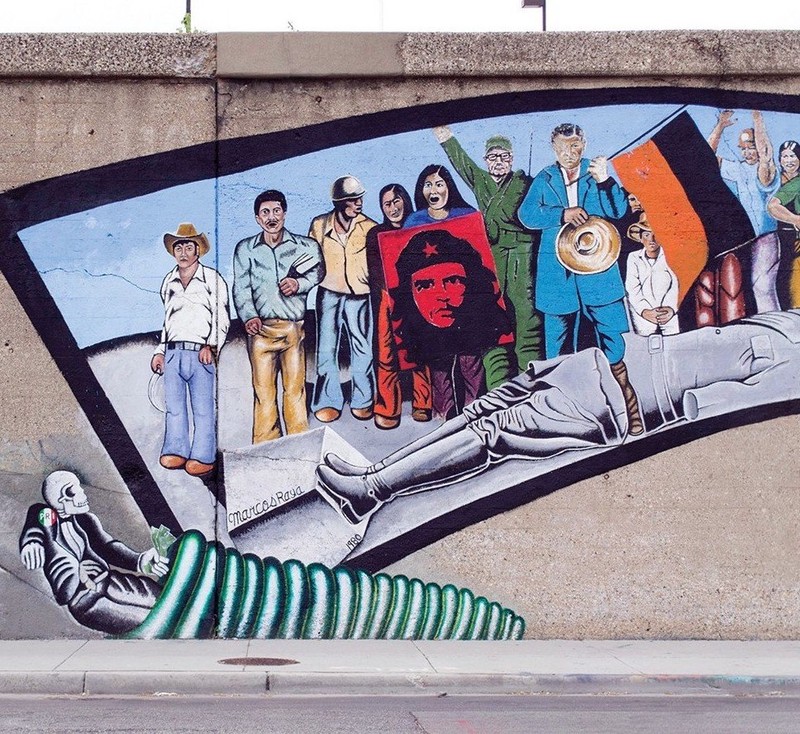
(2)
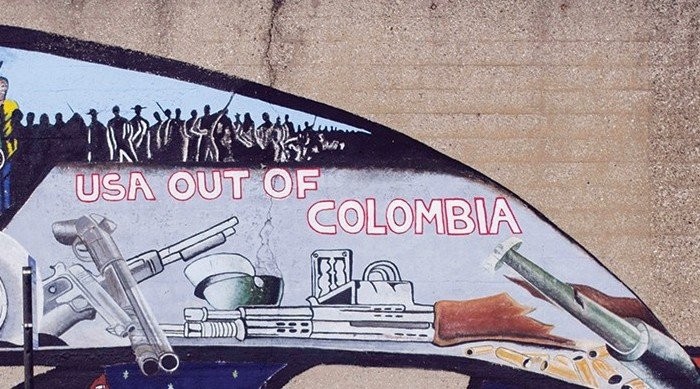
(3)
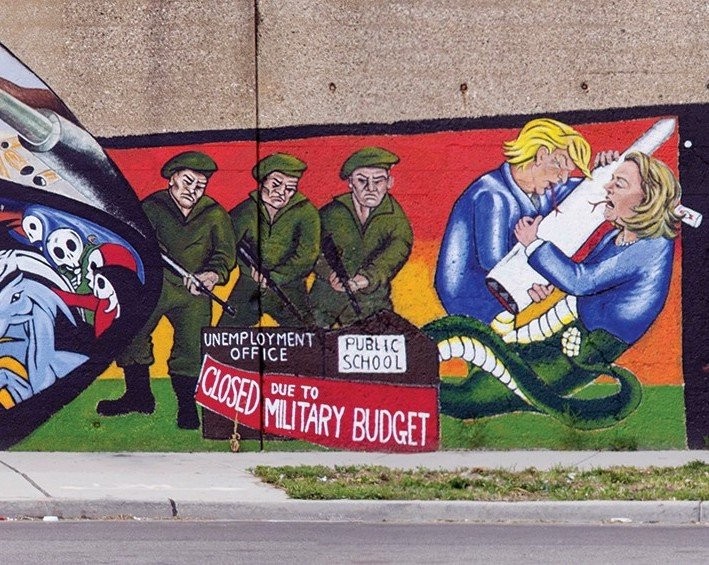
(4)
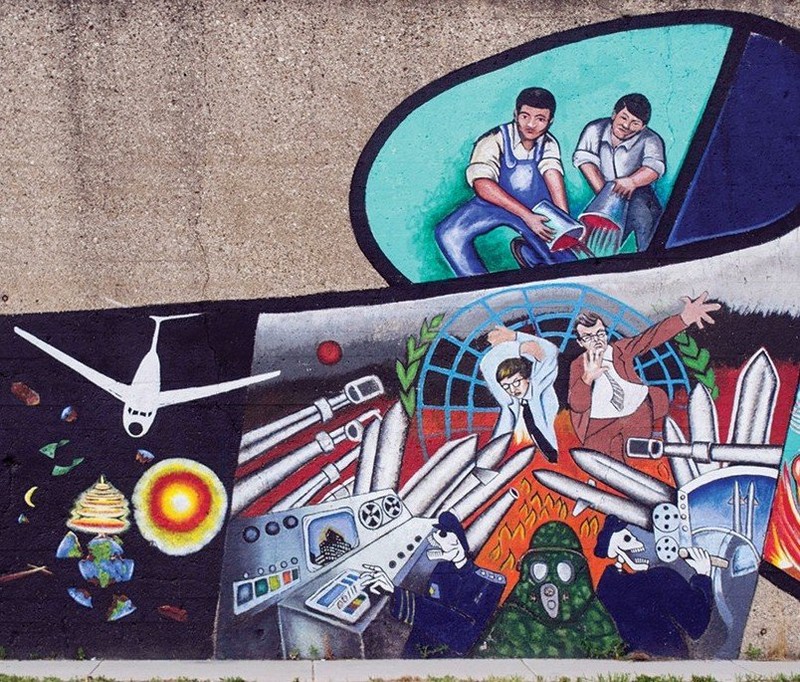
(5)
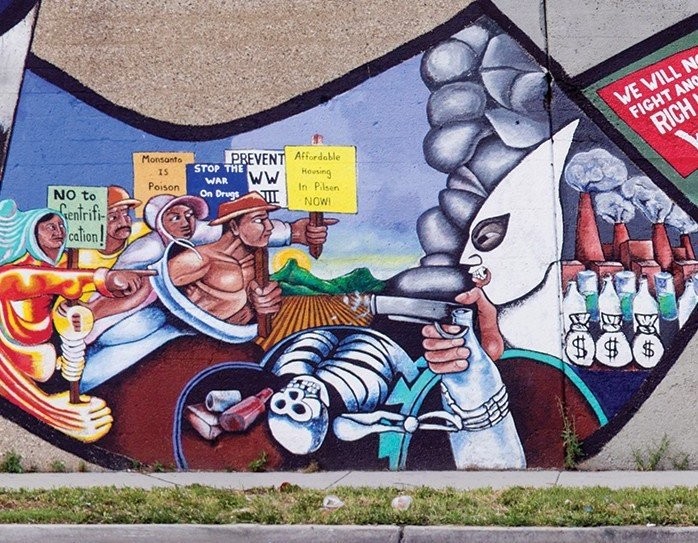
Backstory and Context
Text-to-speech Audio
Mural History
“Prevent World War III,” combines themes of Chicanx or Latinx pride, resistance to American oppression, and anti-war sentiments, in a string of captivating images, painted as if on a reel of film. It was painted in 1980 by a number of Chicago and Midwestern artists, including the still prominent painter Marcos Raya. Recently elected president Ronald Reagan, and the rise of right-wing politics were major sources of inspiration for the mural. Pilsen was home to large Latinx socialist movement just a few decades earlier, with organizations such as the Brown Berets, and spaces like Casa Aztlan and Centro de la Causa. Overall, liberal Chicago activists of the 60s were able to find commonality in protest against the Vietnam war. These community organizations waned in influence as this war ended and years passed. “Prevent World War III” recalls the spirit of community organization and protest, as a reminder and as a warning against complacency. The imagery of warning and protest depicted is still extremely relevant to US politics of oppression to Latinx peoples, both nationally and internationally.
In 2016, one of the original artists, Marcos Raya received a grant to renew the mural. Much of the original paint had faded, and he recolored the previously vibrant scenes. He also decided to add to and alter some of the frames to make them more relevant. One section that previously had Reagan and Jimmy Carter wrestling over a nuke, he repainted as Donald Trump and Hillary Clinton, a reminder of the repetition of US politics. In a revolution scene, he added a statement warning about US military presence in Latin American countries, a trend that has only grown since the 80s. In several protest scenes, he altered signs to be relevant to current events, like gentrification in Pilsen, police brutality in Chicago, and Monsanto’s monopolization of agriculture business. In this sense, mural serves as a dynamic, living piece of artwork, and a reminder of the consistency and sameness of oppression throughout the decades.
Overview of the Mural: (left to right)
Historical context is important for this piece of street art, as almost every frame is rich in very specific imagery relating to local, national, and international struggles at the time of its creation. The images above are numbered, and correspond to the descriptions listed below. You can also use the zoom feature of the Google Maps widget to get a closer look at the mural.
1. The first section of the mural, when moving off of Western Ave and down 18th St, is a depiction of US-backed, Nicaraguan dictator Anastasio Somoza Garcia. His regime was internationally condemned for human rights violations. In the mural, his likeness is that of a shattered statue, representing his eventual overthrow by Nicaraguan leftist revolutionaries. Ironically, a few days after the mural was completed in 1980, Somoza was assassinated in Paraguay.
2. Just to the right of this is a recent addition by Marcos Raya, the all-caps demand “USA OUT OF COLOMBIA.” The call for decreased US military presence in present-day Colombia, next to an image depicting the fallout of US presence in Nicaragua 40 years ago, is a powerful juxtaposition.
3. Next, there is a depiction of US soldiers standing above a facade of a school, with the statement “closed due to US military budget,” a protest against Reagan’s military expansion in the 80s that is still salient.
4. Interspersed among these very political scenes are apocalyptic images of the Earth exploding, and skeletons manning missile stations while the UN symbol burns in the background. These were also very pointed at the Reagan administration and their use of nuclear weapons as a threat to resolve international conflict. Even in these very global scenes of protest, the muralists weave in elements of Latinx culture and history. Above the burning UN pyre, are two Latino men with buckets of water, trying to put it out.
5. Continuing down the wall, there is a protest scene that depicts Latinx people marching with signs like “Say NO to gentrification,” “Stop the War on Drugs,” and the source of the mural’s title “Prevent World War III,” among others. Some of these signs have been updated, while others, like “Stop the war on drugs,” are clearly specific to the 80s, and the original mural. This section of the mural also has an agricultural backdrop, representative of past and ongoing Latinx labor rights movements. To the right of the field is a hooded KKK member, fumigating the field and protesters, a skeleton lying beneath him. This could be a commentary on the hazardous working conditions that Latinx farm laborers face, likening them to the racialized terror and violence of the KKK.
“Prevent World War III,” is very much global in its scope, but its placement in Pilsen is not just a coincidence. Pilsen has been a space of Latinx-centered activism since the 50s and continues to be home to a very active, politically-aware community. This mural is such an important piece of Pilsen history as it weaves in common struggles of Latinx people in the US to the global and ideological struggles of the Cold War era. Many of the messages present in the mural are somewhat radical, but they honor and continue the history of Latinx socialist organizations in Pilsen. The mural reflects both the commonality of struggle that Latinx people face, in the US and globally, while also referencing specific events in Latin American countries that are often ignored or forgotten in history.
Sources
Pupovac, Jessica. History of Pilsen. WTTW. . Accessed May 31, 2019. https://interactive.wttw.com/my-neighborhood/pilsen/history.
Serrato, Jackie. Faces Of Trump, Clinton To Join Iconic Pilsen Mural Under Restoration. DNAInfo. June 01, 2016. Accessed May 31, 2019. https://www.dnainfo.com/chicago/20160601/pilsen/faces-of-trump-clinton-join-iconic-pilsen-mural-under-restoration/.
Huebner, Jeff. A major mural in Pilsen gets a few more years in the sun. Chicago Reader. July 07, 2016. Accessed May 31, 2019. https://www.chicagoreader.com/chicago/marcos-raya-prevent-world-war-iii-mural-street-art/Content?oid=22771667&fbclid=IwAR0thjk1VvdYwWU7_3S-BTkiqgM3DoclKNCyiAiJBo1fjROG5Y3ilS7yBWY.
Lauerman, Connie. BARRIO IS NO BARRIER. Chicago Tribune. September 12, 1995. Accessed May 31, 2019. https://www.chicagotribune.com/news/ct-xpm-1995-09-12-9509120067-story.html.
